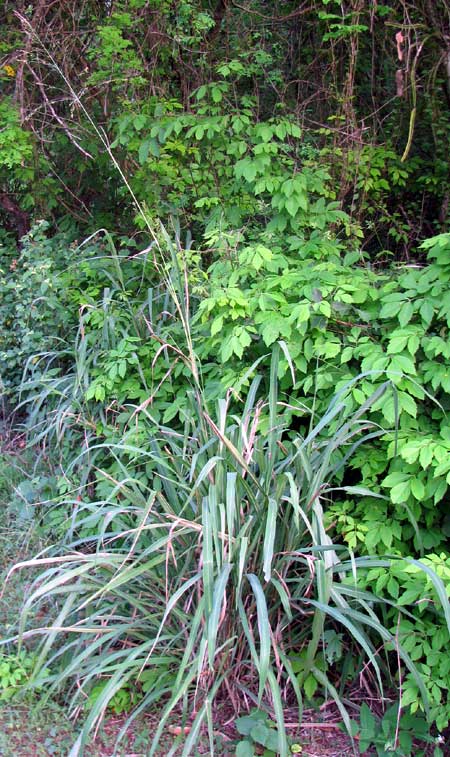Excerpts from Jim Conrad's
Naturalist Newsletter
from the May 9, 2010 Newsletter issued from Hacienda Chichen Resort beside Chichén Itzá Ruins, central Yucatán, MÉXICO; limestone bedrock, elevation ~39m (~128ft), ~N20.676°, ~W88.569°
GUINEA GRASS
I've been waiting for a certain very large, coarse grass to flower so I could identify it, and now it's flowering. In spots where maybe 25 years ago cattle were grazed, this grass forms savanna-like openings in the forest, the tough blades waist to shoulder high. Where trails enter open spaces caused by treefalls, this grass might form a chigger-infested barrier you have to plow through. A small clump of it with its flower head seven feet high (2.1 m) is shown below:

A closer look at the flowering head, a panicle, is below:

Individual spikelets are shown below:

In that picture the brown, dangling items are pollen- producing anthers attached to threadlike filaments. The purple, fuzzy (plumose) items are female stigmas filtering the air for male pollen. The stigmas reside atop a short, necklike style, which tops the hidden, oval ovary, which will mature into a grass fruit, the future grass grain.
These spikelets are typical of the genus Panicum, in which are found the so-called Panic Grasses. In my Flora of McLean County, Kentucky, produced for my Master's Thesis, Panicum was the most prolifically speciating of all grass genera listed, represented by a dozen Panicum species. Panicums produce open flower heads like the one in the picture (flowers in "loose panicles"), with each spikelet containing a single floret. Grass flower anatomy can be reviewed at www.backyardnature.net/fl_grass.htm.
Knowing the genus, it was easy to look at a list of Panicums known to occur in this region and pick out which species this could be. So, what we have here is Guinea Grass, PANICUM MAXIMUM, native to Africa and Yemen but introduced into the tropics worldwide. The species grows naturally in open grasslands, under or near trees and shrubs and along riverbanks.
In much of the tropics Guinea Grass is valued as a species tough enough to survive the tropics' heat and droughts, yet providing good forage for livestock. Its blades contain an unusually high amount of protein. In many cultures, grass is cut at one location, then carried home in bundles to feed to tied-up or fenced-in livestock. Guinea Grass with its long, fairly stiff blades is appreciated for the ease with which it can be carried.
When you're hot and sweaty and have to crash through a lot of scratchy, non-native, tick- and chigger-infested Guinea Grass, it's hard to have good thoughts about this species. However, knowing how useful it is, and how pretty its flowers are up close, maybe some grudging admiration can be spared for it.